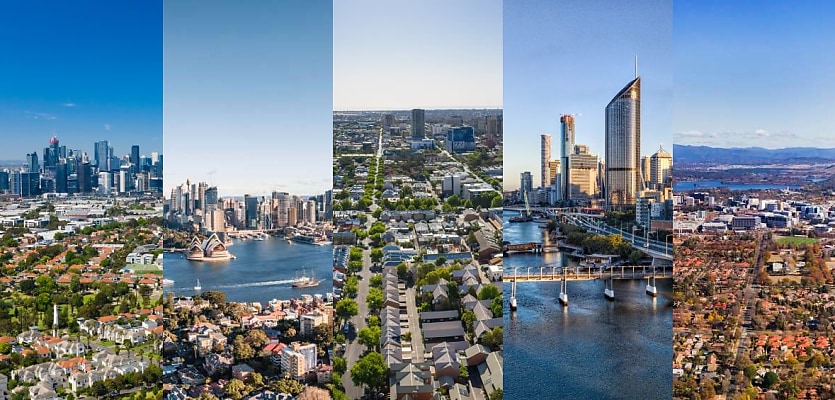Residential property listings across Australia rose by 4.5 per cent in January 2025, reaching 243,642 properties, marking a 10.3 per cent increase from January 2024.
According to SQM Research, the data indicated a strong start to 2025, with rising listings across most major cities.
Brisbane recorded the highest monthly rise at 9.8 per cent with 16,241 listings, up 4.4 per cent from the previous year.
Perth followed suit with a 7.9 per cent monthly increase and a 5 per cent annual rise.
Sydney saw a 7.3 per cent monthly rise, bringing the total listings to 29,791, representing a 19 per cent growth compared to last year.
Adelaide and Hobart recorded monthly gains of 6 per cent and 6.8 per cent, respectively.
Canberra saw a 3.3 per cent monthly increase, contributing to a 30.7 per cent year-on-year surge.
Melbourne’s listings grew the slowest recording a 2.1 per cent month-on-month to 37,873, reflecting a 15.9 per cent annual increase.
In comparison, Darwin was the only city to experience a monthly and yearly decline, with listings falling by 1.3 per cent in January and dropping 24.1 per cent annually.
SQM Research data showed that the rise in listings was concentrated in the private treaty market, as auction listings for the first two weeks of February were down approximately 7 per cent compared to the same period in 2024.
New listings
Data from SQM Research showed that new residential property listings (less than 30 days) rose nationally by 2.9 per cent in January, reaching 53,019 properties, an 18.1 per cent increase from January 2024.
Sydney led the surge with a 61.5 per cent monthly rise, totalling 10,027 listings, up 24.9 per cent annually.
Canberra followed suit, recording the second-highest growth in new listings, at 41.8 per cent annually, after a 10.4 monthly rise.
Brisbane saw a 32.7 per cent monthly increase, reaching 5,898 new listings, with an 18.4 per cent year-on-year gain.
Melbourne recorded a 3.9 per cent monthly rise, with 10,504 new listings, reflecting a 27.2 per cent annual increase.
Darwin’s new listings declined by -12.7 per cent over the month, falling to 131, down 35.5 per cent annually.
Old listings
SQM Research data showed that the number of older residential property listings (over 180 days) increased by 7.2 per cent nationally in January, totalling 71,835 – a 15.1 per cent increase from the previous year.
Perth recorded the largest monthly increase at 21.3 per cent, while Hobart recorded the highest yearly increase at 62.8 per cent.
Darwin saw the smallest monthly rise at 1.6 per cent with 570 older listings, reflecting a 7.9 per cent annual decline.
Perth and Adelaide had the sharpest yearly drops at 37.6 per cent and 23.1 per cent, respectively.
Distressed listings
SQM Research reported that the number of residential properties under distressed conditions nationwide rose to 4,782, a 1.6 per cent increase from the previous month.
Distressed listings define properties available for sale under adverse conditions such as foreclosure or urgent sales to settle debts.
Despite the increase, distressed listings remain 8.9 per cent lower compared to the same period last year, with Tasmania recording the highest jump at 26.1 per cent.
Victoria’s distressed listings rose 1 per cent, marking a 14.5 per cent annual surge, while Queensland posted a 1.8 per cent monthly increase but remained 19.8 per cent lower year-on-year.
The ACT had the most significant monthly decline at 8.3 per cent, though listings remained 22.2 per cent higher annually.
Western Australia also recorded a monthly decline, with distressed listings falling 3.9 per cent to 687 – a 22.3 per cent annual drop.
Asking prices
SQM Research data showed that house prices increased by 0.8 per cent nationally, while unit prices declined by 0.4 per cent, for a combined 0.7 per cent rise.
In capital cities, asking prices fell 0.7 per cent overall, with house prices down 0.8 per cent and unit prices unchanged.
Sydney’s house prices dipped 0.2 per cent, while unit prices rose 0.8 per cent, keeping overall prices stable.
Perth continued its growth, with house prices rising 0.7 per cent and units up 1.4 per cent, leading to a combined 0.8 per cent increase.
Adelaide performed strongly, with house prices climbing 1.5 per cent and unit prices up 3.2 per cent, for a combined rise of 1.7 per cent.
In comparison, Canberra was the weakest performer, with house prices down 1.2 per cent despite a 1.5 per cent rise in unit prices, leading to a 0.6 per cent overall decline.









You are not authorised to post comments.
Comments will undergo moderation before they get published.